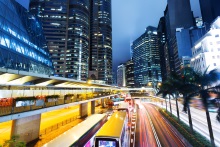COP21 should focus more on urban transport and electric cars

Prior to the UN Climate Change Conference (COP21) in Paris the researchers point to a promising avenue for the transport sector to mitigate climate change. At present, the emissions of this sector account for 23 percent of global CO2 emissions.
Transport emissions are expected to double by 2050, according to IPCC scenarios, mainly because of rapid motorization in China, India, and Southeast Asia. But to achieve the 2° C target, the transport sector would need to stabilize if not halve its emissions by 2050.
“Large-scale electric mobility could be crucial in reducing CO2 emissions in the transport sector by one half by 2050,” lead author Felix Creutzig says, who also contributed to the chapter on transport in the IPCC’s Fifth Assessment Report. Electric mobility at that scale includes car-sharing concepts, electric bicycles and rail transport.
“Efficiency gains will be very difficult to achieve with the conventional automobile fleet from 2025 on. In that context, a fuel shift will be the only remaining option to advance decarbonization.”
Given the continuing drop in battery prices, electric drives have a better starting position than engines running on biofuels or hydrogen, according to the authors. In fact, recent literature has shown that the price per kilowatt-hour has dropped from about $1,000 US dollars in 2007 to about $410 US dollars in 2014. Because of this development, prices for the year 2030 are projected to drop to $200 US dollars.
The Science paper bases its insights on IPCC AR5 transformation pathways and on the Integrated Model to Assess the Greenhouse Effect (IMAGE). Models that offer a systems view focus on what different energy sectors, like the transport sector, could contribute to climate protection.
The Science paper, however, examines transport-related issues within the sector by using more recent and, in some cases more specific, data on how people commute and travel. The results show that there are grounds for cautious optimism – provided policy will follow suit.
Climate protection solutions in the transport sector rely significantly on urban infrastructure policies. “The most effective form of climate mitigation is every single kilometer not driven. This is what also generates the most health benefits, for example by cleaner air,” Creutzig says. “Infrastructure investments in new train tracks or fast-lane bike paths, for example, are negligible when considering that they reduce the need to build more roads and parking lots.”
Such investments also result in positive path dependencies. For example, when parking is made more expensive in downtown areas, accompanied by an improvement of public transport, people tend to give up driving and use other forms of transportation in the city centers. Such shifts can then develop into more permanent habits.
At international climate summits, such as the upcoming Paris conference, urban transport and electric cars do not typically feature in the discussions. “When it comes to really transforming the transport sector on a path towards climate protection, global policy makers have perhaps been a bit timid,” co-author David McCollum from the International Institute for Applied Systems Analysis (IIASA) says. “If we were to replicate best-practice examples that we see throughout the world today, then we could start to harness the potential that’s out there.”
Reference of the cited article:
Creutzig, F.; Jochem, P.; Edelenbosch, O.Y.; Mattauch, L.; van Vuuren, D.P.; McCollum, D.; Minx, J. (2015): Transport: A roadblock to climate change mitigation?, Science, Vol. 350, Issue 6263, pp. 911 – 912
Media Contact
All latest news from the category: Transportation and Logistics
This field deals with all spatial and time-related activities involved in bridging the gap between goods and people, including their restructuring. This begins with the supplier and follows each stage of the operational value chain to product delivery and concludes with product disposal and recycling.
innovations-report provides informative reports and articles on such topics as traffic telematics, toll collection, traffic management systems, route planning, high-speed rail (Transrapid), traffic infrastructures, air safety, transport technologies, transport logistics, production logistics and mobility.
Newest articles

Silicon Carbide Innovation Alliance to drive industrial-scale semiconductor work
Known for its ability to withstand extreme environments and high voltages, silicon carbide (SiC) is a semiconducting material made up of silicon and carbon atoms arranged into crystals that is…

New SPECT/CT technique shows impressive biomarker identification
…offers increased access for prostate cancer patients. A novel SPECT/CT acquisition method can accurately detect radiopharmaceutical biodistribution in a convenient manner for prostate cancer patients, opening the door for more…

How 3D printers can give robots a soft touch
Soft skin coverings and touch sensors have emerged as a promising feature for robots that are both safer and more intuitive for human interaction, but they are expensive and difficult…





















